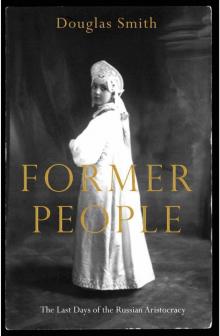- Home
- Douglas Smith
Former People: The Final Days of the Russian Aristocracy
Former People: The Final Days of the Russian Aristocracy Read online
TO EMMA AND ANDREW
There is no more Russian nobility. There is no more Russian aristocracy . . . A future historian will describe in precise detail how this class died. You will read this account, and you will experience madness and horror . . .
—The Red Newspaper (Petrograd),
No. 10, January 14, 1922
CONTENTS
Note on Dates and Spelling
Principal Figures
Family Trees
Maps
Prologue
PART I: BEFORE THE DELUGE
1. Russia, 1900
2. The Sheremetevs
3. The Golitsyns
4. The Last Dance
PART II: 1917
5. The Fall of the Romanovs
6. A Country of Mutinous Slaves
7. The Bolshevik Coup
PART III: CIVIL WAR
8. Expropriating the Expropriators
9. The Corner House
10. Spa Town Hell
11. Bogoroditsk
12. Dr. Golitsyn
13. Exodus
PART IV: NEP
14. School of Life
15. Noble Remains
16. The Fox-trot Affair
17. Virtue in Rags
PART V: STALIN’S RUSSIA
18. The Great Break
19. The Death of Parnassus
20. Outcasts
21. The Mouse, the Kerosene, and the Match
22. Anna’s Fortune
23. Happy Times
24. Poisonous Snakes and the Avenging Sword: Operation Former People
25. The Great Terror
26. War: The End
Epilogue
Note on Sources
Notes
Bibliography
Acknowledgments
Index
NOTE ON DATES AND SPELLING
Before February 1918, Russia followed the Julian (Old Style) calendar that in the twentieth century was thirteen days behind the Gregorian (New Style) calendar used in the West. In January, the Bolshevik government decreed that Russia would adopt the Gregorian calendar at the end of the month; thus January 31, 1918, was followed the next day by February 14. I have chosen to give Old Style dates for events in Russia before January 31, 1918, and New Style after that; wherever there is a chance for any confusion, I have added the notations “O.S.” or “N.S.” A number of documents used in Former People are impossible to date with precision since some Russians continued to use the Julian calendar for years after 1918, and it is not always possible to know which system of dating has been used.
There is no universal standard for transliterating Russian names into English. For the sake of simplicity I have chosen the masculine ending for all surnames (Dolgoruky, not Dolgorukaya), except when the feminine form is well established in English. Difficulty is presented by the various ways members of the same family anglicize their names.appears with equal validity as “Golitsyn,” “Galitzine,” “Golitsin,” “Galitsin,” and “Golitzin.” In such instances I have opted to use the Library of Congress transliteration format but have not silently changed spellings used in quotations. Although such an approach assures the greatest fidelity to the documents upon which Former People draws, it makes for some inconsistency.
PRINCIPAL FIGURES
THE SHEREMETEVS
Count Sergei Dmitrievich Sheremetev—“Count Sergei,” “The count”
Countess Yekaterina Pavlovna Sheremetev (b. Vyazemsky), his wife—“Countess Yekaterina”
Their Children
Count Dmitry Sheremetev—“Dmitry”
Countess Irina Sheremetev (b. Vorontsov-Dashkov), his wife—“Ira”
Count Pavel Sheremetev—“Pavel”
Countess Praskovya Sheremetev (b. Obolensky), his wife—“Praskovya”
Count Boris Sheremetev—“Boris”
Countess Anna Sheremetev (m. Saburov)—“Anna”
Alexander Saburov, her husband—“Alik”
Count Pyotr Sheremetev—“Pyotr”
Countess Yelena Sheremetev (b. Meiendorff), his wife—“Lilya”
Count Sergei Sheremetev—“Sergei”
Countess Maria Sheremetev (m. Gudovich)—“Maria”
Count Alexander Gudovich, her husband—“Alexander”
Their Grandchildren
Children of Dmitry and Irina Sheremetev
Countess Yelizaveta Sheremetev (m. Vyazemsky)—“Lili”
Prince Boris Vyazemsky, her husband
Countess Irina—“Irina”
Count Sergei Sheremetev—“Sergei”
Countess Praskovya—“Praskovya”
Count Nikolai Sheremetev—“Nikolai”
Count Vasily Sheremetev—“Vasily”
Child of Pavel and Praskovya Sheremetev
Count Vasily Sheremetev—“Vasilik,” “Vasily”
Children of Anna and Alexander Saburov
Boris Saburov—“Boris”
Xenia Saburov—“Xenia”
Georgy Saburov—“Yuri”
Children of Pyotr and Yelena Sheremetev
Count Boris Sheremetev—“Boris”
Count Nikolai Sheremetev—“Nikolai”
Cecilia Mansurov, his wife—“Cecilia”
Countess Yelena Sheremetev (m. Golitsyn)—“Yelena”
Prince Vladimir Golitsyn, her husband—“Vladimir”
Countess Natalya Sheremetev—“Natalya”
Count Pyotr Sheremetev—“Pyotr”
Countess Maria Sheremetev—“Maria”
Count Pavel Sheremetev—“Pavel”
Children of Maria and Alexander Gudovich
Countess Varvara Gudovich (m. Obolensky)—“Varvara,” “Varenka”
Prince Vladimir Obolensky, her husband—“Vladimir”
Count Dmitry Gudovich—“Dmitry”
Countess Maria Gudovich (m. Istomin, Lvov)—“Merinka”
Pyotr Istomin, her first husband—“Pyotr”
Sergei Lvov, her second husband—“Sergei”
Count Andrei Gudovich—“Andrei”
Count Alexander Dmitrievich Sheremetev—“Count Alexander”
Countess Maria Fyodorovna Sheremetev (b. Geiden), his wife—“Countess Maria”
Their Children
Countess Yelizaveta Sheremetev—“Yelizaveta”
Count Dmitry Sheremetev—“Dmitry”
Countess Alexandra Sheremetev—“Alexandra”
Count Georgy Sheremetev—“Georgy”
THE GOLITSYNS
Prince Vladimir Mikhailovich Golitsyn—“The mayor”
Princess Sofia Nikolaevna Golitsyn (b. Delianov), his wife—“Sofia”
Their Children
Prince Mikhail Golitsyn—“Mikhail”
Princess Anna Golitsyn (b. Lopukhin), his wife—“Anna”
Prince Nikolai Golitsyn—“Nikolai”
Princess Maria Golitsyn (b. Sverbeev), his wife
Princess Sofia Golitsyn (m. Lvov)—“Sonya”
Konstantin Lvov, her husband
Prince Alexander Golitsyn—“Alexander”
Princess Lyubov Golitsyn (b. Glebov), his wife—“Lyubov”
Princess Vera Golitsyn (m. Bobrinsky)—“Vera”
Count Lev Bobrinsky, her husband—“Lev”
Prince Vladimir Golitsyn—“Vladimir Vladimirovich”
Princess Tatiana Golitsyn (b. Govorov), his wife—“Tatiana”
Princess Yelizaveta Golitsyn (m. Trubetskoy)—“Yelizaveta,” “Eli”
Prince Vladimir Trubetskoy, her husband—“Vladimir”
Princess Tatiana Golitsyn—“Tatiana�
�
Pyotr Lopukhin, her husband
Their Grandchildren
Children of Mikhail and Anna Golitsyn
Princess Alexandra Golitsyn (m. Osorgin)—“Lina”
Georgy Osorgin, her husband—“Georgy”
Prince Vladimir Golitsyn—“Vladimir”
Countess Yelena Sheremetev, his wife—“Yelena”
Princess Sofia Golitsyn (m. Meyen)—“Sonya”
Viktor Meyen, her husband—“Viktor”
Prince Sergei Golitsyn—“Sergei”
Klavdia Bavykin, his wife—“Klavdia”
Princess Maria Golitsyn (m. Veselovsky)—“Masha”
Vsevolod Veselovsky, her husband—“Vsevolod”
Princess Yekaterina Golitsyn—“Katya”
Child of Nikolai and Maria Golitsyn
Prince Kirill Golitsyn—“Kirill”
Natalya Volkov, his wife—“Natalya”
Children of Alexander and Lyubov Golitsyn
Princess Olga Golitsyn—“Olga”
Princess Marina Golitsyn—“Marina”
Princess Natalya Golitsyn—“Natalya”
Prince Alexander Golitsyn—“Alexander”
Prince George Golitsyn—“George”
Children of Vera and Lev Bobrinsky
Countess Alexandra Bobrinsky (m. Baldwin)— “Alka”
Philip Baldwin, her husband
Countess Sofia Bobrinsky (m. Witter)—“Sonya”
Reginald Witter, her husband
Count Alexei Bobrinsky—“Alexei”
Countess Yelena Bobrinsky
Children of Vladimir Vladimirovich and Tatiana Golitsyn
Prince Alexander Golitsyn—“Alexander”
Darya Krotov, his wife—“Darya”
Princess Yelena Golitsyn—“Yelena”
Princess Olga Golitsyn (m. Urusov)—“Olga”
Prince Pyotr Urusov, her husband—“Pyotr”
Children of Yelizaveta (Eli) and Vladimir Trubetskoy
Prince Grigory Trubetskoy—“Grisha”
Princess Varvara Trubetskoy—“Varya”
Princess Alexandra Trubetskoy—“Tatya”
Prince Andrei Trubetskoy—“Andrei”
Princess Irina Trubetskoy—“Irina”
Prince Vladimir Trubetskoy—“Volodya”
Prince Sergei Trubetskoy—“Sergei”
Prince Georgy Trubetskoy—“Georgy”
Their Great-grandchildren
Children of Vladimir and Yelena Golitsyn (b. Sheremetev)
Yelena Golitsyn (m. Trubetskoy)—“Yelena”
Andrei Trubetskoy, her husband
Mikhail Golitsyn—“Mishka”
Illarion Golitsyn—“Lariusha”
PROLOGUE
THE CORNER HOUSE, MOSCOW, NOVEMBER 23, 1918, LATE EVENING
The nurse was preparing a fresh bandage when the men from the Cheka, the feared Bolshevik political police, burst into the room. “Can’t you see there’s a man dying in here?” she asked, and turned, stopping them in their tracks.1 There before them in the half-light lay Count Sergei Dmitrievich Sheremetev, aged seventy-three, aide-de-camp to the late emperor Alexander III, member of the Imperial State Council, chief master of the hunt, and scion of one of Russia’s great aristocratic families. In poor health for years, Count Sergei was near death, the gangrene in his legs spreading toward his torso and requiring the doctors to make one last attempt to save his life by radical amputation. The unexpected visitors, all except one, filed out of the room. The leader of the group, Yakov Peters, an intense man with thick dark hair and a prominent forehead, stayed to observe the operation and see whether the man he had come to arrest would survive.
They had arrived without warning, driving up Vozdvizhenka Street in several cars from the direction of the Kremlin. After turning into the courtyard of the Corner House, the grand Sheremetev home, they parked and locked the gate behind them to keep anyone from escaping. Panic gripped the servants on the main floor of the Corner House. At first it was not clear what was happening; ever since the abdication of Tsar Nicholas II the previous year and the collapse of the old regime the country had descended into chaos and lawlessness. Armed gangs roamed the streets at night, robbing, looting, and killing at will. Once powerful and still enormously rich families like the Sheremetevs were their preferred victims. Yet as the men in their dark leather jackets barged into the house, it became clear these were not mere bandits, but members of the All-Russian Extraordinary Commission for Combating Counterrevolution and Sabotage, the so-called Cheka.
After mounting the main staircase, they charged into the dining room, where they found the Sheremetev family seated at the table. “Hands up!” shouted Peters, leveling his Nagant revolver at them. Stunned, they all remained seated and raised their hands. Even the old butler, Dmitry Fyodorovich, just then serving Countess Yekaterina Sheremetev, Count Sergei’s wife, laid the food platter on the floor and put his hands in the air. Not seeing Count Sergei at the table, Peters and a few of the other Chekists went to find him. The adults were locked in the dining room for the night, while the Sheremetev grandchildren were permitted to go to their nanny in another part of the house. Among the children were Yelena Sheremetev, in a gold silk skirt, her long hair tied up with a big white bow, and her older brother, Nikolai. When the children told their nanny what was happening, she took the family jewels that had been sewn to a long piece of velvet and dropped them into a water tank, just as she had been instructed to do in such an event.
Many in the family had sensed this day was coming; there had been numerous signs during the past months that the Bolsheviks had placed the Sheremetevs in their sights. That summer two of Count Sergei’s sons-in-law had been briefly arrested: Alexander Saburov, a former officer of the Chevaliers Gardes and civil governor of Petrograd, and Count Alexander Gudovich, a gentleman of the bedchamber at the court of Nicholas II. Shortly thereafter, a Red Army soldier had come to the house and arrested Baron Joseph de Baye, a French citizen and old friend of Count Sergei’s, who had lived with the family for many years. When the count asked on whose orders his friend the baron was being arrested, the soldier pointed at the Kremlin, saying, “Theirs.” In September, the count’s son, also named Sergei, was arrested at the family estate of Ostafievo, the Cheka agents mistaking him for his father. A group of worried scholars wrote to Anatoly Lunacharsky, the Bolshevik commissar of enlightenment, requesting that he extend “special protective measures” to the count and his son Pavel at their Vozdvizhenka home. Lunacharsky replied that “all Revolutionary powers” would be used for their protection.2 The commissar evidently had little power to offer protection.
The importance the Bolsheviks attached to Count Sheremetev, one of the most prominent representatives of old Russia, the Russia now being swept away by the whirlwind of the revolution, was evident by the presence of Yakov Peters that night at the Corner House. Born to the family of a poor Latvian farmer, Peters had been a committed revolutionary since the beginning of the century. He had been arrested by the tsarist police for taking part in labor strikes and tortured after the Revolution of 1905. For the rest of his life he had the mangled fingernails to prove his commitment to the cause. After his release he fled to London in 1908. Peters returned to Russia in the spring of 1917 and played an active role in the Bolsheviks’ seizure of power in October. Together with Felix Dzerzhinsky, he established the Cheka and for years served as one of its leaders, notorious for his cruelty.3
Peters was among the authors of the Red Terror unleashed in September 1918 after the murder of Moisei Uritsky, head of the Petrograd Cheka, and the failed assassination attempt on the life of Lenin by Fanya Kaplan in late August. The goal of the Cheka’s terror was to unleash a campaign of class warfare against “counterrevolutionaries” and so-called enemies of the people. In September, the Communist leader Grigory Zinoviev pronounced: “To overcome our enemies we must have our own socialist militarism. We must carry along with us 90 million out of the 100 million
of Soviet Russia’s population. As for the rest, we have nothing to say to them. They must be annihilated.”4 Peters’s Cheka colleague Martin Latsis let there be little doubt where these unfortunate ten million were to be found: “Do not look in the file of incriminating evidence to see whether or not the accused rose up against the Soviets with arms or words. Ask him instead to which class he belongs, what is his background, his education, his profession. These are the questions that will determine the fate of the accused. That is the meaning and essence of the Red Terror.”5 Peters himself had expounded on the role of terror: “Anyone daring to agitate against the Soviet government will immediately be arrested and placed in a concentration camp.” The enemies of the working class will meet with “mass terror [. . .] and will be destroyed and crushed by the heavy hammer of the revolutionary proletariat.”6
The hammer of the Red Terror had now been lowered on the Corner House. Yakov Peters and Sergei Sheremetev embodied the epochal struggle facing Russia in 1918: on one side stood Peters, young, strong, and armed with the righteous conviction of the Bolshevik cause; on the other lay Sheremetev, sick, weak, defeated, and dying. In Count Sergei’s room that night, two Russias stood face to face—that of the future and that of the past.
History, we are told, is written by the victors. What is less often stated, though no less important, is that history is usually written about the victors; winners get more attention in the history books than losers. The literature on the Russian Revolution proves the point. The biographies of Lenin vastly outnumber those of Nicholas II, as do the books on the Bolsheviks compared with those on the Mensheviks. Yet losers are no less worthy of being remembered than winners, if only to help us to appreciate the full richness of what came before and to preserve the memory of those unjustly forgotten by history.
I came across this forgotten history while writing a book on Count Sergei’s grandfather Count Nikolai Sheremetev, an eccentric and fabulously rich aristocrat famous for his private serf opera company and his scandalous marriage to its prima donna, a singer named Praskovya Kovalyova, who performed as “The Pearl.”7 Through my research I came to know several of Nicholas and Praskovya’s descendants, and hearing their stories about what had happened to the family during the revolution, I was drawn to the larger history of the fate of the nobility during these tumultuous years. While on a visit to Moscow in the spring of 2006 I searched the many drawers of the card catalog devoted to the “Great October Socialist Revolution” at the Russian State Library (the former Lenin Library, not fully online at the time) but could not find anything on the nobility. Surprised, I asked a librarian why there was nothing in the catalog. The look she gave me was one of disbelief, as if I had asked who was buried in the Lenin mausoleum. “Shto? What?” she stuttered. “The revolution and the nobility? Of course not, because the revolution had nothing to do with the nobles, and they had nothing to do with the revolution,” she instructed this clueless American historian.8 While researching this book, I have received similarly dismissive comments from people in the West. Of course, the nobility was destroyed, I have been told, and rightly so. There is a belief among some people that the nobility got what was coming to it, and so we need not be surprised or even care. Both points of view—that the revolution had nothing to do with the nobility or that it did but need not concern us—are wrong, historically and morally.

 A Bird in the Hand
A Bird in the Hand Out of the Light
Out of the Light Former People: The Final Days of the Russian Aristocracy
Former People: The Final Days of the Russian Aristocracy Spirit Dance
Spirit Dance